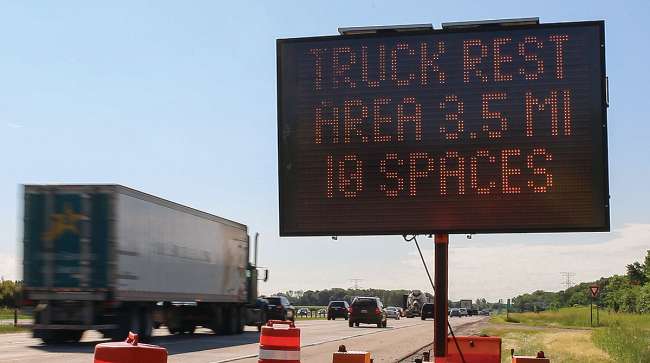Staff Reporter
Midwestern States Unite to Mitigate Truck Parking Problems

A group of eight Midwestern states is working to inform truckers of parking availability along major routes.
Indiana, Iowa, Kansas, Kentucky, Michigan, Minnesota, Ohio and Wisconsin, represented by the Mid America Association of State Transportation Officials, are developing a shared truck parking information management system that offers real-time data on how many spaces are available at certain lots.
Davonna Moore, head of the Kansas Department of Transportation’s multimodal planning group, explained that each state will be furnishing public rest areas with intelligent transportation systems that are capable of determining how many truck parking spaces are occupied. Most of the states also are erecting signs along major interstates that reflect the names of nearby rest areas, the exits where those lots are located and the number of spaces available. The states will begin constructing the signs this spring and summer. After a test period in the fall, the system is scheduled to be completely functioning by January 2019.
“We view this as one big, large project,” Moore said. “We did not want the truck drivers to deal with eight different systems.”
The shortage of available truck parking ranked No. 4 on the American Transportation Research Institute’s list of most pressing concerns for trucking, which was released Oct. 23.

Bruning
“We forecast that truck volumes will increase by 67% by the year 2040, so we have to find innovative solutions to meeting that additional demand,” said Ohio DOT spokesman Matt Bruning.
The project is funded through a $25 million Transportation Investment Generating Economic Recovery grant, awarded in 2015 and dispersed across the eight states based on the number of sites they requested to be fitted with technology.
According to Indiana DOT spokesman Scott Manning, the TIGER grant funded design and construction costs. Moore said U.S. DOT subsequently added $6.2 million to the project.
In addition to the signs, there will be physical technology placed at sites that will record parking availability. Moore said states have two primary options: count-in/count-out systems and space-by-space indicators. The count-in/count-out systems keep a tally of trucks as they move in and out of a rest area. Space-by-space systems use presence detection technology such as cameras or indicators embedded in the pavement to read each spot.
Moore said that the latter method is generally used for smaller sites and, although it is the more costly option, requires less maintenance in the long run.

Mescher
According to Phil Mescher, Iowa DOT’s project manager for the Truck Parking Information Management System, the state will use both options at rest areas along the 300-mile portion of Interstate 80 that runs through the state.
Minnesota, on the other hand, will solely use space-by-space sensors at seven rest areas along I-35 and I-94.
“We thought it would be economical,” said Dan Rowe, intelligent transportation system project manager for Minnesota DOT.
Moore said that the scanning technology and signs will be backed up by “behind-the-scenes” software systems. The data gathered from the devices can be provided to travelers over state 511 travel sites. It also can be used by third-party vendors, such as Waze or Google Maps.
Disseminating data is a chief goal for Iowa DOT, which Mescher said is not constructing signs to broadcast parking availability. Mescher said that Paul Trombino, Iowa DOT’s former director, did not want to build signs and would rather share the data with third-party developers. Trombino withdrew his name from consideration for Federal Highway Administration chief in early December.
“He wanted to focus more on its information, where we would push the data out and let third party developers develop apps that would consume the data,” Mescher said of Trombino.


